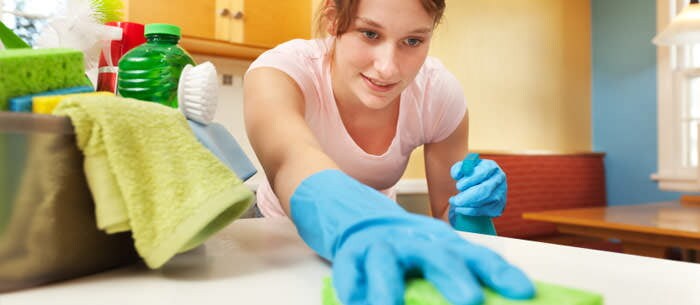If your kitchen is so greasy that it glistens or if your kids have taken to drawing in the dust, it might be time to seek professional help to scrub the spots that will make the place shine.
“When your home is clean and organized, it allows you to live your life to its fullest, minimizing stress and maximizing your productivity,” says Barbara Reich, a professional organizer.
Whether you’ve hired a cleaning company for a one-time deep clean or you just want to help guide your regular housekeeper, it’s important to know (and easy to forget!) all of the areas you’ll expect to be cleaned. Make sure you’re getting the most for your money and ending up with a spotless home. Use this handy list to get you started.
Kitchen
1. Refrigerator:
Toss expired food, and wipe down shelves from top to bottom. To avoid lingering smells associated with pungent cleaners, use a mixture of baking soda and water instead.
2. Oven and stove:
Don’t forget to clean grease off of the stove hood, an area that easily accumulates residue. And for easy oven clean up, spray oven cleaner inside of the oven on a day you’re not planning to use it, then let it sit overnight. The next day, the baked-on gunk should come off easily when wiped down.
3. Microwave:
Instead of using harsh cleaners, simply microwave a cup of water with a little lemon juice on high power for three to five minutes. The resulting steam will naturally loosen stuck-on foods. Then wipe away.
4. Counters:
When wiping counters, run the cloth or paper towel over appliances and cabinets, especially the handles, to wipe off food, fingerprints, dust and grease.
5. Appliances:
Appliances that always sit out are usually in plain sight, yet they can also be overlooked when cleaning a kitchen. Coffee makers and coffee pots, fruit bowls, blenders and toaster ovens can collect dust, so they should be wiped off with a damp paper towel.
6. Kitchen cabinets:
Be sure both the interior, exterior and top (if applicable) of the cabinets get cleaned. Always begin at the top shelf and work your way down.
7. Floor:
Different types of flooring require different types of cleaning. Linoleum is best cleaned with apple cider vinegar, as cleaners high in pH tend to be too abrasive and can damage the flooring. If you have laminate floors, use a dry mop like Swiffer or a damp sponge mop and clean, hot water. It’s important the mop is well rung out, as too much water can be harmful to laminate floors. For a deeper clean, add four ounces of ammonia or laminate floor cleaner. Hardwood floors can be cleaned with plain old white vinegar and water.
Bathrooms
8. Mirror:
Wipe off residue and be sure not to leave streaks or splashes from spraying the counters.
9. Sinks and tubs:
To clean sinks and tubs, use a foaming cleanser that soaks in place for easier cleaning. Also wipe down faucet fixtures, which tend to collect evidence of splashes.
10. Toilet:
For a natural way to clean the toilet with minimal work, pour a quarter cup of baking soda into the toilet bowl after flushing. In about 15 to 20 minutes, come back and give the toilet bowl a quick scrub before flushing to rinse.
11. Floors:
Keep tile floors shiny and prevent mould and mildew build up by rubbing them with lemon oil after sweeping, mopping and letting the floor dry. To get in between the grout, mix powdered oxygen bleach with water. It’s nontoxic and doesn’t emit bad fumes.
Bedrooms and Living Areas
12. Under furniture:
Vacuum under beds, sofas and dressers, where dust and hair is often blown during regular cleanings. Use a vacuum attachment to reach far corners.
13. Curtains and blinds:
Vacuum attachments are also handy for running over curtains and blinds, or use a disposable cloth duster to quickly pick up dust.
14. Lampshades and televisions:
People tend to forget that lampshades and televisions also attract a lot of dirt and dust. Make sure these are turned off before using a vacuum attachment or microfiber cloth to clean them.
Laundry Room
15. Washer/dryer:
No matter how careful you are, detergent always seems to spill! Be sure the tops and sides of the washer and dryer are cleaned off. Lint traps should be cleaned out very regularly.
Throughout Your Home
16. Windows:
You should clean the inside part of your windows and skylights at least twice a year and the outside at least once a year. If you live in an area with a lot of pollen or smog, you may have to do it more regularly. Make sure you wipe down windows, sills and trims.
17. Air vents:
Clean your air vents frequently, as dust starts to accumulate, and change up the filters at least twice a year. Not only does regularly checking air filters when you clean reduce the overall amount of dust in the house, but also it helps families with allergies avoid the sniffles.
18. Ceiling fans and corners:
For hard-to-reach spots like ceiling fans and corners, use vacuum attachments. Ceiling fans are often forgotten, so they tend to carry a lot of dust. Corners, whether on the floors or ceilings, attract spiders, webs and–subsequently–more dust.
19. Doors:
Hand prints accumulate on the flat surfaces of doors and dust and grime tend to settle on the tops and around the frames.
20. Floors:
Vacuum and mop floors as your last step, to pick up dirt and dust that may have transferred to the floors during the rest of the cleaning process.
By freelance writer Maria Adcock
